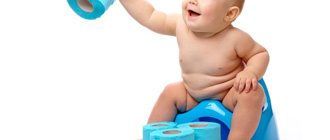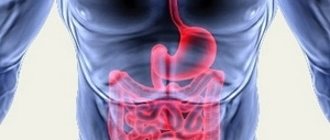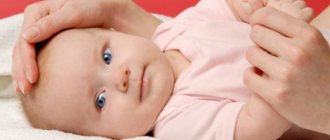Rotavirus infection is highly contagious. A sick person releases trillions of virus particles, and in order to get sick, a hundred are enough. Therefore, it doesn’t matter who brought the virus into the house, the whole family usually gets sick. Infants under one year of age are at greatest risk. It is vital for them to start treatment on time.
In the article we will consider a situation when both mother and baby are sick. Let's answer the questions:
- Is it possible to continue breastfeeding during illness of the mother or child?
- How to treat a nursing mother?
- How to protect the baby if the mother is sick?
- How to feed a baby, and what should a mother eat?
Symptoms of the disease in mother and baby
Rotavirus infection, regardless of age, is characterized by three symptoms: diarrhea, vomiting and high fever. Let's look at the manifestations of each of the symptoms in more detail so that you can start supporting your body with the right actions in time. In most cases, this will eliminate the development of a severe form of the disease and the need for hospitalization.
- The temperature does not exceed 39 degrees and lasts up to four days. Against the background of dehydration, the temperature cannot be brought down.
- Vomiting is frequent from 2 to 20 times a day. The younger the child, the more frequent the attacks. Vomiting goes away within 2-5 days.
- Frequent, foamy, yellow stools. Usually watery and without impurities. Diarrhea may persist for up to two weeks.
The disease begins suddenly, violently and, with the right actions, disappears in 2-5 days, depending on the severity of the disease.
- In a mild form, the disease can occur at normal body temperature and last several days. Relief occurs already on the second day.
- The disease of moderate severity lasts a week, recovery begins in 3-4 days.
- Severe forms require hospitalization and IV drips. The disease lasts up to 2 weeks, relief occurs after a week.
Sometimes more dangerous diseases are mistaken for rotavirus, so call a doctor immediately if the following symptoms appear:
- Streaks of fresh red blood in the stool
- The color of the stool has become black with a metallic tint - this is also a sign of intestinal bleeding
- Lethargy, apathy, dry skin and mucous membranes appeared, facial features became sharper - this indicates severe dehydration.
- Stool more than 10 times a day and vomit more than 7 times. For children, this is very dangerous due to the development of dehydration.
- Severe constant pain in the abdomen. Not to be confused with gripping pain that may occur at the onset of the disease.
- A rash on the body can be a signal of a typhoid infection.
Childhood and adult manifestations of the disease are the same. Mothers often tolerate it more easily due to the maturity of the digestive system and previously formed immunity.
Babies, especially those under one year old, are seriously ill. The main danger is the rapid onset of dehydration due to frequent vomiting and diarrhea. Dehydration, in turn, disrupts all life processes. In infants, the risk of this condition is especially high due to low body weight and the immaturity of many body systems.
What painkillers can you take while breastfeeding?
When breastfeeding, it is safe to take the following painkillers: Paracetamol, Ibuprofen, Drotaverine (“No-shpa”), Ketorolac (“Ketorol”, “Ketanov”, “Ketalgin”). Injections of lidocaine or articaine are suitable for pain relief during dental treatment. For local anesthesia for bruises and some other injuries, you can use ointments based on diclofenac.
| Allowed | Prohibited |
| Paracetamol | Metamizole sodium (Analgin) |
| Ibuprofen | Nimesulide (“Nimesil”, “Nise”) |
| Drotaverine ("No-shpa") | Acetylsalicylic acid (“Citramon”, “Aspirin”) |
| Ketorolac (“Ketorol”, “Ketanov”, “Ketalgin”) |
Is it possible to breastfeed a child with rotavirus?
It is not only possible, but also absolutely necessary to maintain breastfeeding in all cases - no matter who is sick - the mother or the baby, or both.
- Firstly, with mother's milk, antibodies are transferred to the baby, which protect it and help cope with the disease
- Secondly, milk contains water in the most biologically available form. Therefore, breastfeeding helps fight dehydration.
How not to infect a child if the mother is sick with rotavirus
The virus is shed in the stool. In the first days of illness, it lives in the oral cavity, so it makes sense to wear a mask while feeding, wash your hands very thoroughly after using the toilet, before feeding and any contact with the child. Ventilate and clean with disinfectants. The baby should be isolated from the sick mother and brought only for feeding.
Diarrhea due to poor diet
If a nursing mother has food poisoning, the first step is to identify the food that caused the diarrhea. Next, cleanse the body of waste and toxins using safe sorbents and adjust the diet.
On the first day, drinking plenty of fluids, bed rest if possible, and minimal food consumption are recommended. Eating dried bread and crackers will relieve pangs of hunger and stop diarrhea.
Taking probiotics and prebiotics to normalize the activity of microflora will speed up treatment. You can breastfeed your baby if there are no signs of intoxication.
Drinking regime
The most acute period is the first 3-4 hours. This is called the rehydration period, when you need to ensure you are drinking enough. For both sick adults and children. You should drink not just water, but an oral rehydration solution that contains salts. It can be bought at a pharmacy and can be easily prepared at home. Read the recipe in our article: “Rotavirus in infants: causes, symptoms, diagnosis and treatment.”
For the mother, the main recommendation is to use the amount of oral rehydration solution that does not cause vomiting. You can start with 1-2 tablespoons every 5 minutes.
Infants are fed from a spoon, cup or syringe in small doses every 5-10 minutes. If the child refuses to drink, you need to insist to prevent dehydration. We do this for 4-8 hours until the symptoms of dehydration disappear: dry skin, mucous membranes, constant desire to drink, and regular urination improves. Next, give the drink on demand and after each episode of vomiting or diarrhea.
Treatment at home
At home, first of all, you need to establish nutrition. Eliminate possible factors for diarrhea. Introduce light vegetable broths into your diet, prepare dishes only by boiling, stewing or steaming.
By following a simple diet, you can easily help yourself with mild diarrhea.
If you have diarrhea, you should increase the amount of fluid you drink; it is better to drink purified, clean water rather than various types of drinks. Be sure to include strengthening foods in the menu - rice, rye bread, hard-boiled eggs, jelly from fruits and berries allowed during lactation.
It is imperative to exclude fatty, fried, salty, spicy foods, fresh vegetables, fruits, sweets, carbonated drinks, coffee, peach and plum compotes, and other ingredients that have a laxative effect.
It is not recommended to consume fermented milk products. For diarrhea, cereal porridges, low-fat meats, potatoes are allowed, and with tea - dried bread, rolls without additives, and crackers.
Treatment of rotavirus infection with diet
Let's talk about diet for mother and child. It is important to understand the principle. Then creating a menu will become easier. Rotavirus damages the intestinal villi, and the absorption of nutrients is impaired. For the same reason, the production of the lactase enzyme, which breaks down the milk sugar lactose, is reduced. Secondary lactase deficiency develops, that is, milk intolerance.
The basic principle of nutrition: a gentle diet with the exception of dairy products. You can try fermented milk products.
For babies, the most important thing is continuity of nutrition to avoid nutritional deficiencies and weight loss, which is especially important in the first year of life.
- Breastfeeding continues as required. The baby may ask for the breast more often because he is thirsty. All recommendations to stop breastfeeding during the period of rotavirus are unfounded. WHO and the Ministry of Health recommend maintaining breastfeeding during illness.
- Babies who eat formula are transferred to low-lactose or lactose-free formulas for 2-3 weeks. There must be indications for switching to hypoallergenic mixtures. Only the doctor can decide this. It is important to take into account that they taste bitter, the baby may refuse to eat, and it is important for us to maintain nutrition. During the rehydration period (the first 3-4 hours), you don’t have to feed the child - just give him water. Then offer food in small portions that will not cause vomiting. Gradually switch to the usual volumes of the mixture. The classic transition to another mixture takes a week. You don’t have this time during illness, so transfer your baby to a new formula one time. The discomfort from a sudden transition will undoubtedly be less than the harm from continuing to feed formula.
Materna Soy, a lactose-free formula based on soy protein, is suitable for babies from birth. Made in Israel. Delivery throughout Russia from a warehouse in Moscow.
What should you not eat if you have rotavirus infection?
Children who receive complementary foods and adults should exclude dairy products, as well as foods that create a greater burden on digestion: raw vegetables and fruits, foods with added sugar, juices, broths. It is worth postponing the consumption of fried, spicy and fatty foods.
What can you eat if you have rotavirus infection?
You can feed mother and child with foods that are easily digested, so that the body spends a minimum of resources on digestion and directs more energy to recovery. It is recommended to add salt to food, even if you have not yet salted your child’s food. This will help retain water in the body. Nutritionists allow adding salt to food from the age of one year in the amount of 1 gram per day.
Causes of diarrhea
It is difficult to avoid diarrhea during lactation, given the many factors that can cause watery stools. After pregnancy and childbirth, not only the hormonal background changes, but also the immune system weakens, chronic diseases worsen, which leads to an upset stomach.
Why does mother have diarrhea?
- drinking large amounts of water to maintain lactation - pediatricians advise drinking at least 3 liters of liquid per day. As a result, the intestines relax, and in the absence of foods with a fixing effect, diarrhea occurs;
- improper nutrition - sleep patterns are disrupted, as a result food intake is not controlled, night snacks appear, which lead to intestinal stagnation, the body does not digest food well, gastrointestinal diseases worsen;
- toxicity of the body - violation of hygiene rules, consumption of poor-quality food, entry into the body of a helminthic infection, which leads to nausea, vomiting, stool disorders, general weakness, etc.;
- damage to the intestinal mucosa by allergens - medications, food, pollen, fluff, animal hair;
- stress factors - lack of sleep, chronic fatigue, conflicts in the family, in the environment, unfavorable atmosphere in the house, such factors can lead to malfunctions of the digestive system, causing diarrhea;
- abuse of coffee-containing drinks - caffeine leads to relaxation of the gastrointestinal tract, which leads to the appearance of loose stools.
If diarrhea occurs once, there is no need to panic; just drink activated charcoal, eat a portion of rice porridge, and brew strong tea. The main thing is not to fix the child’s stool during breastfeeding. And for diarrhea that lasts more than 2-3 days, it is important to seek help from a specialist.
Terms of use
Dr. Komarovsky, for example, recommends avoiding the use of painkillers while breastfeeding or pregnant, as some drugs simply have not undergone proper clinical studies. However, if a woman cannot tolerate severe pain, there is no point in waiting for it to go away on its own or using dubious traditional methods. Here are a few rules that will help you quickly deal with the problem and avoid harming yourself and your child:
- It is important to understand: painkillers only relieve the symptom, but do not cure the disease itself. Therefore, in case of painful discomfort, it is recommended to consult a doctor, find the cause of the discomfort and eliminate it. So, if you have a toothache, visit the dentist; if you have pain in your ear, visit an ENT doctor. If the root cause is not eliminated, the pain will occur again and again, requiring another dose of medication.
- Even for a drug prescribed by a doctor, check the instructions, or rather the section “Use during pregnancy and breastfeeding.” There are no prohibitions - take it, and in the recommended dosage. But! The quantitative transfer of drugs into mother's milk has been studied only for a few drugs. Therefore, in most cases, you will see that the drug has not been studied during pregnancy and lactation, or pregnancy and lactation are contraindications for use (precisely due to the lack of studies on this group). Some mothers try to reduce the harm of drugs by reducing the dose. It is not recommended to do this; the expected effect will not happen (especially if we are talking about products that are acceptable during breastfeeding!).
- Look in the instructions for an indicator that is important for us - the drug elimination period. As a rule, it is the same for blood plasma and breast milk. This way you can calculate the period when the drug leaves your body. Analgesics penetrate into the blood and into mother's milk at the same time: this requires only half an hour, the maximum concentration occurs after 1–1.5 hours. And they appear longer – up to 2–7. The half-life of paracetamol, for example, is about 3, and acetylsalicylic acid - up to 7.
Prohibited drugs
All of these pills are almost certainly in your medicine cabinet. But they are strictly prohibited for women who are breastfeeding. This list included:
- Analgin. In most countries, this drug is generally prohibited for use (not only by nursing women), as it contains a substance that provokes the development of agranulocytosis. If it gets into breast milk, it has an extremely negative effect on the functioning of the baby’s kidneys and circulatory system. Analgin is part of Baralgin, Tempalgin, Spazmalgon, Pentalgin, Spazgan. Approved for use only in the most extreme cases, at high temperatures that are not affected by other medications. Then an intramuscular injection of analgin with diphenhydramine and papaverine is given. However, only a doctor can prescribe such radical methods!
- "Nimesil" ("Nise", "Nimid" and other drugs based on nimesulide). Has an almost instant pain relieving effect. But due to the lack of a sufficient number of clinical studies, it is prohibited for use by pregnant and lactating women, as well as children under 12 years of age.
- Acetylsalicylic acid (aspirin and citramone). It negatively affects the functioning of the gastrointestinal tract of the baby and contributes to disruption of the kidneys and hematopoietic system.
Lactase deficiency (or lactose intolerance)
According to specialized literature, diseases of carbohydrate metabolism associated with changes in the activity of enzymes that break down sugars, including lactose, are extremely rare in the population. Data vary from country to country. The incidence of such diseases varies from 1 in 20,000 to 1 in 200,000 children. Why do pediatricians talk about lactose intolerance in almost every second child?
How could humanity survive if this disease, which leads, for example, to malnutrition in the absence of treatment and death, occurs in the majority of infants? Humanity has been able to survive to this day because true lactose intolerance, genetically determined and associated with the complete absence or serious deficiency of necessary enzymes, is very rare. What happens very often? What do modern doctors constantly face? With lactose intolerance resulting from improperly organized breastfeeding.
If a mother feeds her baby 6-7 times a day, “saves” milk for feeding, pumps after feedings, or shifts the baby to one breast or the other during feeding, there is a very high probability of developing lactose intolerance. This is the same lactose intolerance, the development of which is caused by an imbalance between the “front” and “back” portions of milk. It turns out that the child feeds mainly on the “front” portion of milk, which is more liquid and contains a large amount of lactose. Between feedings, the breast also collects mainly “front” milk, “hind” milk, which is thick, fattier, and is formed mainly during the baby’s sucking. If the mother transfers the baby 5-10 minutes after the start of feeding to the other breast, he will suck the foremilk from it too. Mom expresses hind milk. The baby will not gain weight very well, sometimes just not enough. He may have loose stools with greens and foam. Mom will think that she has bad milk, even though there is a lot of it.
The same situation can happen if the mother limits the child’s sucking, for example, strictly for 15-20 minutes. The baby often does not have time to reach the hindmilk. And, besides, he does not sufficiently stimulate the breasts to produce milk if he suckles for 15-20 minutes 6-7 times a day. Therefore, in parallel, in the situations described above, a lack of milk will develop. When a child begins to be fed with a lactose-free formula, he will begin to gain weight, everyone will breathe a sigh of relief and the myth that milk can be bad and that modern women generally have little of it will be strengthened in their minds. Transient, temporary lactase deficiency also occurs. A child on properly organized breastfeeding, with good weight gain, generally in good health, has foamy stools in the first 2-3 months of life (and sometimes longer). If the mother tells the doctor about this, an examination will be ordered, and sugar will be detected in the analysis. The child will be switched to a lactose-free formula. However, incomplete absorption of lactose is common for a breastfed baby!!! (66% of children aged 6 weeks and 60% of children aged 3 months).
One mother, for example, in such a situation was told: “Your child is experiencing severe pain! Look how gassy he is! And you continue to feed him with your milk! It’s poison for him!!!” I'm not saying that all doctors act this way. I know pediatricians who, seeing that the child is quite well, do not begin to treat him, relying only on the laboratory results obtained, and do not even prescribe unnecessary examinations! Let's remember that for the last 50 years, doctors have dealt primarily with children who were fed formula. Accordingly, much knowledge and laboratory tests are applicable only to this group of children. The presence of sugar in the stool of a formula-fed baby is a pathology. It is normal for a breastfed baby to have sugar in their stool!
A significant amount of sugar may be a consequence of incorrect recommendations for feeding the baby (frequently changing breasts during feeding, limiting the duration of sucking, pumping after feeding), because The baby receives plenty of lactose-rich foremilk. Lactose intolerance and a newborn baby are an unheard of combination!!!









